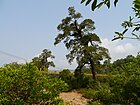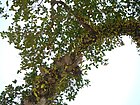Note: This is a project under development. The articles on this wiki are just being initiated and broadly incomplete. You can Help creating new pages.
Calophyllum apetalum
Calophyllum apetalum is an evergreen tree. It grows up to 8 - 30 metres tall. The bole, which is unbuttressed is up to 80cm in diameter. The tree is harvested from the wild for its edible fruit, the oil from its seed and its timber.
Contents
[hide]- 1 Uses
- 2 Parts Used
- 3 Chemical Composition
- 4 Common names
- 5 Properties
- 6 Habit
- 7 Identification
- 8 List of Ayurvedic medicine in which the herb is used
- 9 Where to get the saplings
- 10 Mode of Propagation
- 11 How to plant/cultivate
- 12 Commonly seen growing in areas
- 13 Photo Gallery
- 14 References
- 15 External Links
Uses
Constipation, Wounds, Eczema[1].
Parts Used
Chemical Composition
Calophyllum apetalum leaves contained Crude protein, Crude fiber, Carbohydrate, and Energy. The leaves also contained Iron, Calcium, Sodium, Magnesium, PPM Potassium, and Phosphorus. Moreover, 11.51% Alkaloid, 2.48% Triterpenoid, 2.37% Flavonoid, 7.68% Tannin, 2.16% Saponin, 2.53% Polyphenol, were identified in the methanolic crude extracts of C. inophyllum leaves.[2]
Common names
| Language | Common name |
|---|---|
| Kannada | Kallahonne, Bobbimara |
| Hindi | NA |
| Malayalam | NA |
| Tamil | Cherupinnai |
| Telugu | NA |
| Marathi | NA |
| Gujarathi | NA |
| Punjabi | NA |
| Kashmiri | NA |
| Sanskrit | Punnaga, Surapunnaga |
| English | Konkan Beauty Leaf Tree |
Properties
Reference: Dravya - Substance, Rasa - Taste, Guna - Qualities, Veerya - Potency, Vipaka - Post-digesion effect, Karma - Pharmacological activity, Prabhava - Therepeutics.
Dravya
Rasa
Guna
Veerya
Vipaka
Karma
Prabhava
Habit
Identification
Leaf
| Kind | Shape | Feature |
|---|---|---|
Flower
| Type | Size | Color and composition | Stamen | More information |
|---|---|---|---|---|
| Flowering season is from March to May |
Fruit
| Type | Size | Mass | Appearance | Seeds | More information |
|---|---|---|---|---|---|
| Fruiting season is from March to May |
Other features
List of Ayurvedic medicine in which the herb is used
Where to get the saplings
Mode of Propagation
How to plant/cultivate
A plant of the moist to wet tropics, where it is found at elevations up to 1,735 metres. [4]
Commonly seen growing in areas
Locally abundant in riverine forests, Usually along streams.
Photo Gallery
References
- ↑ Jump up to: 1.0 1.1 1.2 ”Karnataka Medicinal Plants Volume-3” by Dr.M. R. Gurudeva, Page No.255, Published by Divyachandra Prakashana, #6/7, Kaalika Soudha, Balepete cross, Bengaluru
- Jump up ↑ Asian Pacific Journal of Tropical Biomedicine, Volume 7, Issue 9, September 2017 - Identification of phytochemical compounds in Calophyllum inophyllum leaves
- Jump up ↑ [Morphology]
- Jump up ↑ Tropical The Ferns Information
External Links
- Ayurvedic Herbs known to be helpful to treat Constipation
- Ayurvedic Herbs known to be helpful to treat Wounds
- Ayurvedic Herbs known to be helpful to treat Eczema
- Herbs with Bark used in medicine
- Herbs with Leaf used in medicine
- Herbs with Seed's oil used in medicine
- Herbs with common name in Kannada
- Herbs with common name in Tamil
- Herbs with common name in Sanskrit
- Herbs with common name in English
- Habit - Evergreen tree
- Index of Plants which can be propagated by Seeds
- Herbs that are commonly seen in the region of Locally abundant in riverine forests
- Herbs that are commonly seen in the region of Usually along streams
- Herbs
- Pages without herbs images




